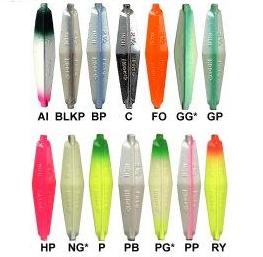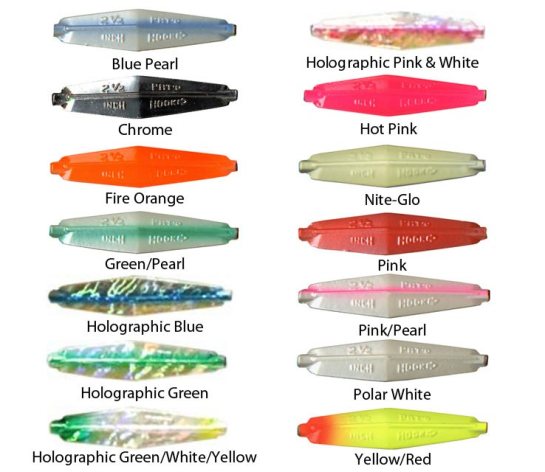From what I’ve seen and personal experience, Buzz Bomb lures tend to be generally unknown and under used. Before I go any further, I have to stop and thank LipRipper from NCKA for suggesting them to me.
I’ve used them once before, and that was in a lake long ago for trout. Don’t remember really doing very well. Admittedly it was probably because I was much younger and didn’t take the time to consider how they worked, and reflect on how I should impart action via the rod to the lure in the right way. So lets dive into this, and keep in mind I’m going to focus on using these for rock cod!
They work AMAZINGLY for rock cod of all types. To date I’ve landed a BnY (black and yellow rock cod), numerous blacks & blues, a cabezon, ling cod, gophers, chinas, and greenling / sea trout. All on the holographic pink buzz bomb lures in 4″ size, except for the cabbie. Cabezon was caught on a 5″ yellow + red(RY in picture below) tipped buzz bomb. All the colors seem to work, but I still have the most confidence in the pink holo.
I have had hits on the holographic blue and green, but haven’t used them much. I tried a 5″ chrome as well, but snagged it before I got a hit.
I have tried the green/pearl before and couldn’t get any bites. Not saying it doesn’t work as that day we only caught fish on bait, but I’m definitely much less confident fishing it, which is certainly a factor.
Now that we’ve covered the colors I’ve tried, lets move onto how they work. Haven’t really seen any good videos of how they flutter and dance in the water, so here’s a short section showing how they look in the water. If I remember I’ll get some better footage of it (maybe even from underwater!) in the future.
Note how the lure turns horizontal and spins/flutters down. Theoretically this sends out high frequency sounds and vibrations annoying/enticing fish to the area & to bite. It does look quite appetizing. If you go to the beginning of the video, or some of my other videos from that trip (https://www.youtube.com/playlist?list=PLvxmnsEpOyAGgC6a3xvjMQKe2Evx_K6uo) you can see that it will catch many different sizes of fish. A 4″ buzz bomb will land you anything from a 4″ rock cod to a 20″+ fish.
Now, to fish these properly you’ll want to raise the rod tip somewhat slowly, otherwise the hook may get tied up in the line. Then on the drop either drop the rod tip all the way down fast, or quickly follow the lure down. I’ve heard and experienced mixed results. Sometimes you’ll get hit on the way down, sometimes on the way up. In all honesty they work so well that I’m not too worried, and I just let it flutter down on slack line.
Keep a close eye on the line as you let it flutter down. If it stops suddenly, twitches oddly, or does anything besides drop at a regular pace, close your bail and try a hook set! Either you’ve hit the bottom or some kelp, or a fish just tried to eat it! If you wait and let it keep dropping, you just give the fish a chance to spit the hook. Always remember, constant pressure to keep the hook embedded.
A few important things to note:
- Do not lose the rubber stopper that comes with it. Be careful when opening the package. Place this between the lure and the hook to protect your knot on the hook, or you may find you lose your lures after an hour or two of fishing the lures.
- Make sure the lure is on in the right direction. The colored side of the lure will indicate which side the hook should be on. Don’t vary from this.
- Add a small plastic bead (pretty much any fishing store should carry these) between the rubber stopper/bumper and the lure. This will allow the lure to spin more freely. If it rubs against the rubber bumper it will spin slower if at all. This also creates a clicking sound every time the lure bumps into the bead, this should attract & entice rock cod further.
- May or may not work well with braid. I’d recommend tying a mono tippet/shock leader of at least 6″, no heavier than 20lb.
- Switching the hook is an option that should be considered. Treble hooks are infamous for getting snagged on air. Well not really, but you get the point. You know you’re going to be fishing rocks, reefs, kelp, so consider swapping the hook out for a 3/0 octopus hook, or whatever you’re comfortable using.
- Bait. I would advise not attaching any bait to these. The action alone seems to be effective enough for rock cod at least. Bait will hamper/impair the action of the lure, and may even cause your hook to tangle with your line more. Haven’t tested, but I suspect that would be the result more often than not.
As for the knot to tie the hook onto the line I’d recommend the clinch or improved clinch knot. Its nice and tight, low profile. This way the lure and bumper can drop flush against the hook and increase your chances of setting the hook. If you swap out to for a non treble hook I’d go with the snell knot. More flush and I feel its the stronger of the two knots.
I believe the 4″ers are roughly 1.8oz, and the 5″ are 2.2oz or something. In case you wanted a general idea of weights. So far off a kayak I’ve found a 4″ is plenty heavy (even in 6-7 mph winds), and the 5″ was a little heavy. Snagged the 5″ a lot, and it doesn’t work too well on the light tackle I prefer to run (8lb test, light trout poles).
There you go, set to go! If you’ve got any more questions, feel free to leave a comment and I’ll try to answer as quickly as possible! Now get out there and catch dem rockies!

